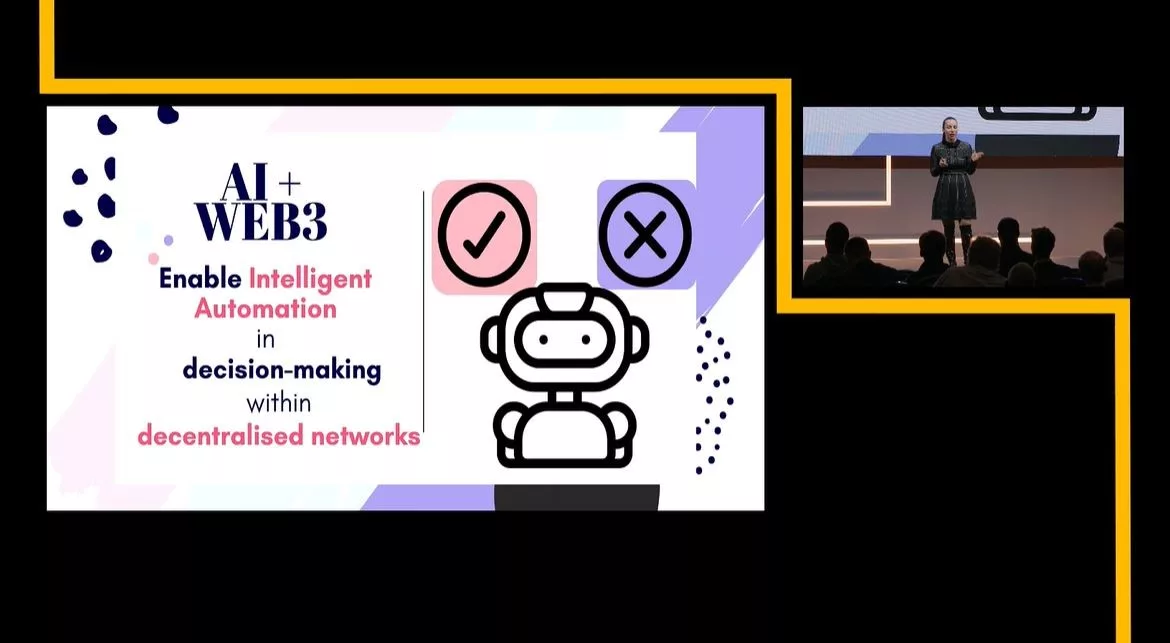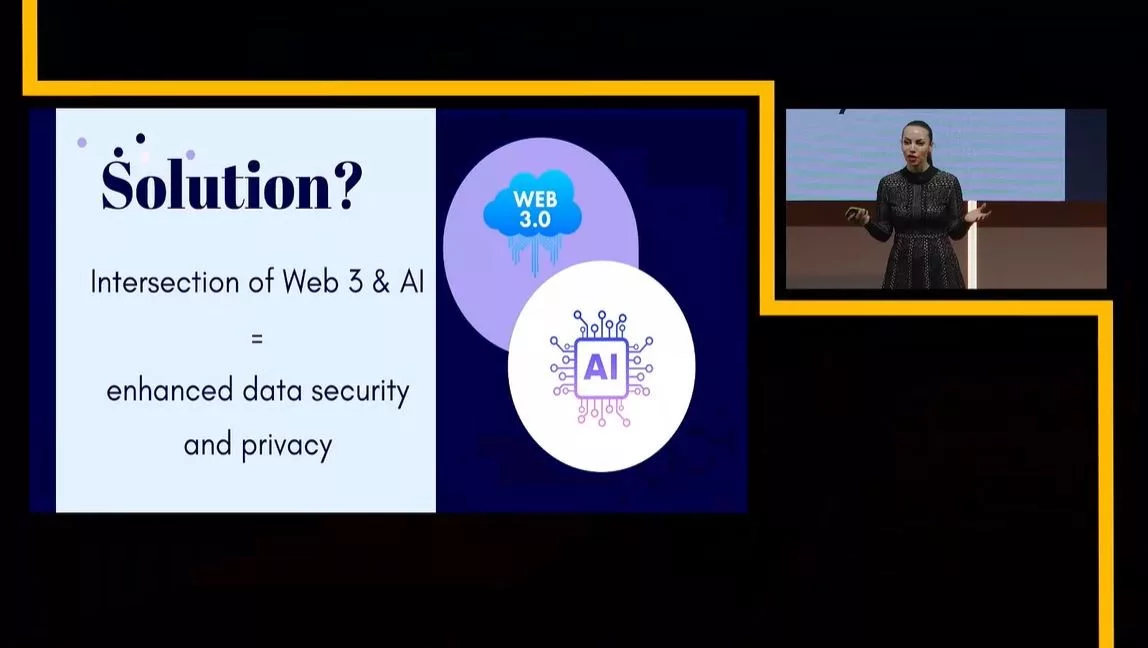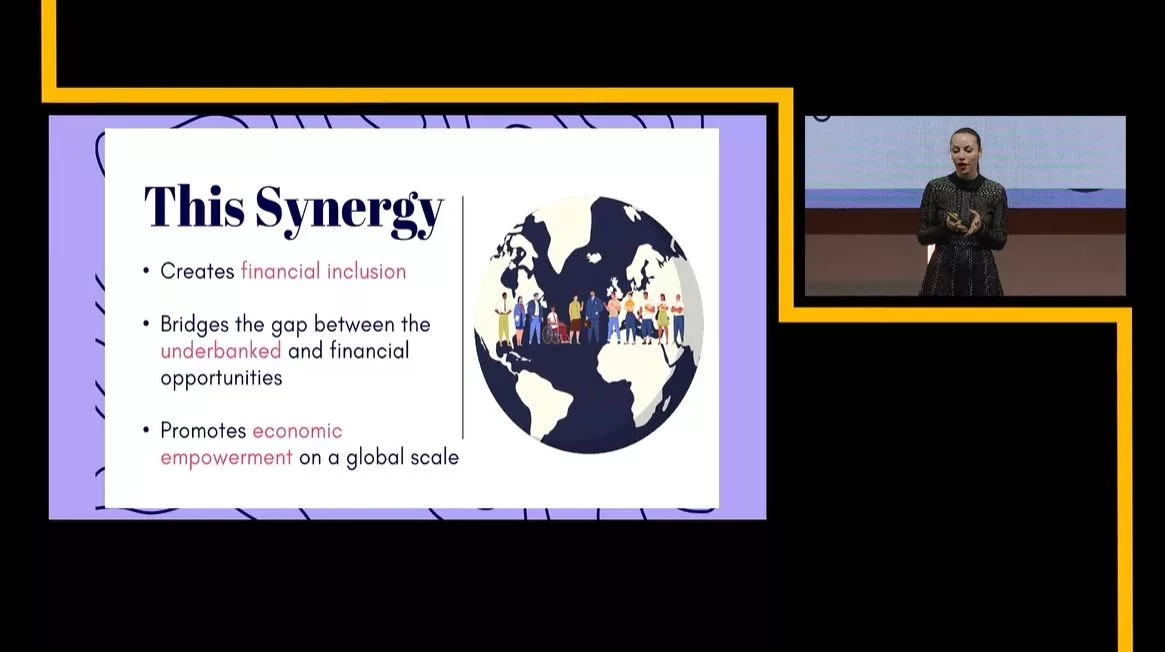|
Getting your Trinity Audio player ready...
|
Following two full days of blockchain and Web3 sessions with a leaning toward practicality and hands on experience, the Day 3 of London Blockchain Conference 2024 began on a more philosophical note.
At least, the opening keynote of the day was delivered by a woman often described as a tech philosopher. Somi Arian is a renowned entrepreneur, speaker, and filmmaker. Her widely awarded 2018 documentary, “The Millennial Disruption,” explored the impact of internet and modern technology on the titular generation, while a book titled “Career Fear (And How to Beat It)” was released in 2020.
Before a packed audience on the conference’s main Visionaries Stage, Arian used her varied personal and professional experience to discuss the changes brought about by Web3 and artificial intelligence (AI) technology and the opportunities these changes present.

She started by polling the room with a peppy enthusiasm that persisted throughout the session.
“How many here are developers?” A few hands went up. “A lot of what I’ll be talking about comes down to you guys.”
“How many are owner-operators—in other words builders?'”
Slightly more hands went up. One can only guess at the predicament of those in the first category who nevertheless consider themselves builders.
“How many are investors interested in number go up?” No hands went up.
Having taken her census, Arian launched into her keynote.
“A lot of people here are like me—I call myself an owner-operator. Someone who tries to build in this space.”
Despite this role, Arian said that she had been forced to step back from the digital asset industry due to some key challenges that she sees as not being addressed. Arian also believes that she’s not alone, and because of the emergence of AI in the public consciousness, blockchain is being left in the dust. Our thunder, she beamed, is being stolen by AI.
However, Arian’s thesis—in keeping with many of the other visionaries who have taken the stage this week—is that blockchain and AI have much to offer one another. The reality of AI’s current cultural dominance is that we may need to lead with AI technology that is quietly supported by blockchain technology rather than the other way around.
“In some ways, I’d say practically that AI needs blockchain more than blockchain needs AI: blockchain brings that level of security and immutability that AI needs. But from the viewpoint of public perception, that’s where we need the integration with AI more to make the blockchain more palatable to the general public.”
Such packaging is important because AI currently faces problems that blockchain can help solve.
According to Arian, a large component of this is the way that the blockchain can empower decentralization and democratization and enhance data security and privacy.

“If you think of AI as a centralized force and Web3 as a decentralized force, they balance each other,” she says.
An easily identifiable example of the potential synergy between these two is that, together, they enable intelligent automation in decision-making within decentralized networks.
Consider the decentralized autonomous organization (DAO), one of the more exciting new paradigms invited by blockchains. One of the issues budding DAOs face (as perhaps shown by the lack of hands that shot up when Arian asked the audience how many DAO members there are) is decision fatigue. As nice as the idea of having all decisions made by the community at large might sound, the reality for those decentralized decision-makers is they get bombarded by decision requests and sooner or later tune them out.
“It’s the ultimate level of democracy – but it’s difficult in practice. We only have so much attention, and our attention span is being pulled in every direction.”
Arian said that AI can help with this. A suitable AI that is familiar with your activities across channels and your preferences could make those decisions for you, giving a virtual assistant some level of autonomy to vote on the (presumably) more minor decisions.
She followed this train of thought onward, comparing terms and conditions. How many people sit and read the fine print before clicking ‘accept’? An AI could read and interpret these terms and either present them succinctly to its master or decide whether to accept or reject them on their own.
Arian ran through other potential synergies: think of AI’s role in conducting advanced analytics and machine learning. Making use of decentralized blockchains could allow this to be done without compromising data privacy, in addition to the more general benefit of having AI combing through on-chain data to detect fraud.

“One of the really good examples of the type of solutions we can have is federated learning. This trains a machine learning model across decentralized data sources without sharing the actual data.”
“This mitigates one of the core concerns people have with LLMs,” she said. In other words, the overhanging question of where all of the data we input into these models will go and how it will be used.
Ultimately, the goal of combining these two technologies is decentralized AI, Arian said. That is where the magic is going to happen. It’s a paradigm shift: AI models and data processing on a decentralized network rather than relying on centralized servers.

But one of the primary barriers to realizing this potential is scalability, the mention of which practically sent a wave of audible hand twitching rolling through the crowd. Arian shared experience building a platform that communities would use to create live and on-demand content with collaboration tools. They put effort into building this and raised money, but the problem is that while it was token-gated, it still wasn’t decentralized. This is because Arian couldn’t find any blockchain that could host the kind of data they needed: all the live sessions, the various collaborations, and so on.
“The truth is that yes, in principle, it’s a great idea, but in practice, there are a lot of obstacles in the way. We don’t have the type of blockchains that are able to handle that amount of data that is needed for AI development.”
One could only imagine what a Q&A session started at that precise moment would have yielded.
Regardless, in that sense, she says, blockchain is falling behind. If we can’t keep up with the capacity demand, ultimately, people will stop developing for blockchain.
The ultimate thrust of Arian’s presentation, and the ostensible answer to how blockchain can keep up with AI, is that whatever we do, we need to be faster and do it sooner.
In order for artificial intelligence (AI) to work right within the law and thrive in the face of growing challenges, it needs to integrate an enterprise blockchain system that ensures data input quality and ownership—allowing it to keep data safe while also guaranteeing the immutability of data. Check out CoinGeek’s coverage on this emerging tech to learn more why Enterprise blockchain will be the backbone of AI.
Watch: Day 2 Highlights of the London Blockchain Conference 2024

 12-13-2025
12-13-2025 





